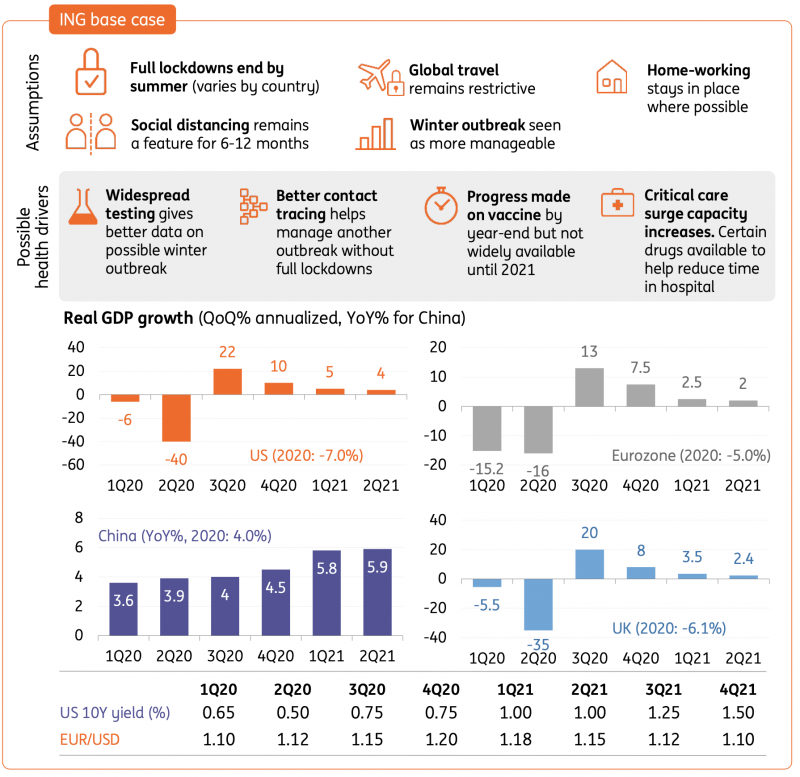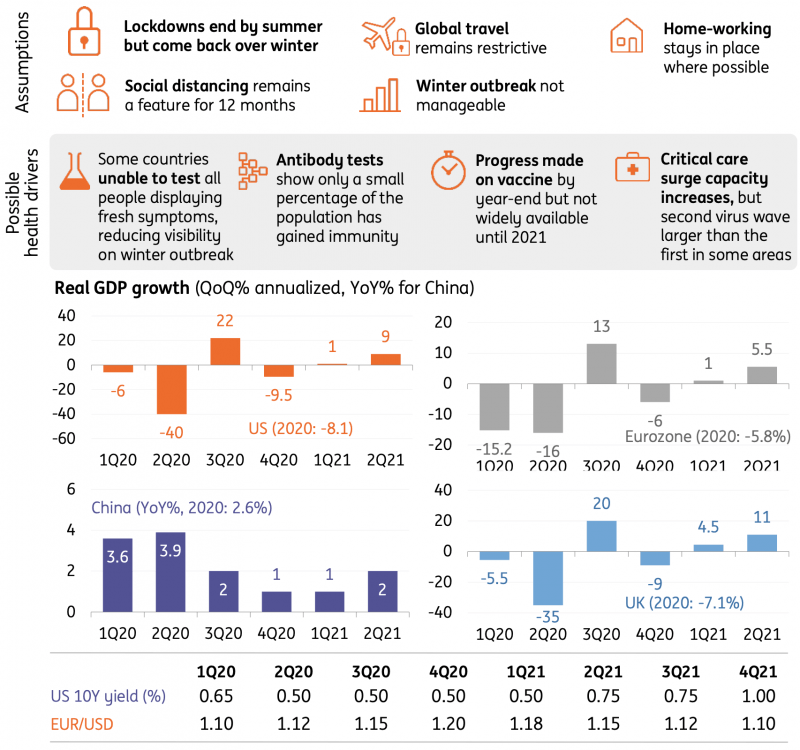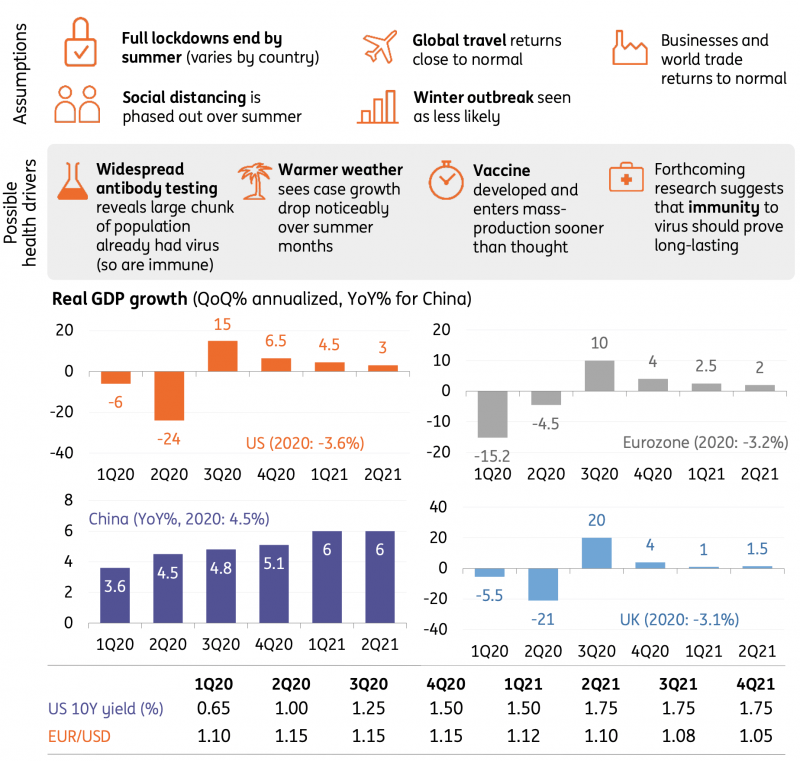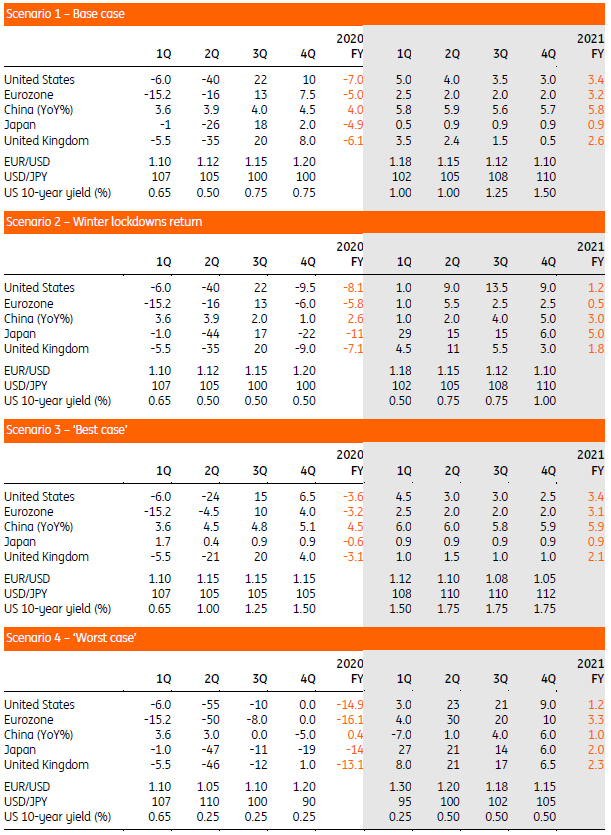We map out the hit to the global economy and possible path for recovery under four different coronavirus scenarios
Scenario 1: Our base case
We've discussed our base case, and what that means for the major economies, in other parts of our latest monthly update.
It assumes that the lockdowns eventually manage to flatten the curve, although not entirely. Given socio-economic tensions and the significant economic fallout, the first European governments decide to begin relaxing the lockdown measures at the end of April. Others will follow in May. The return to normality is gradual, and social distancing continues for at least the entire summer.
A proportion of those who can work from home continue to do so for the foreseeable future. Meanwhile, places, where you can socialise (pubs, cinemas etc), begin to open with strict distancing rules in place. Global travel remains restrictive, but a combination of vaccine development, more widespread testing capacity and higher surge capacity within critical healthcare services, means full lockdowns can be largely avoided if the virus spreads again as we approach the northern winter.
As a result, the economic recovery will be u-shaped. Still, most countries will experience a more severe contraction of economic activity than during the financial crisis.
Our base case at a glance
Source: ING
Scenario 2: Winter lockdowns return
This is a slight variation of our base case scenario.
It starts off in much the same way, with a gradual easing of lockdown measures in May and June. However, in this scenario, the virus returns in the autumn and despite more widespread testing efforts and contact tracing, the new spread pushes most economies back into lockdown.
Crisis management is more experienced than in Spring 2020 and containment measures could be more tailor-made, keeping some regions and sectors up and running. For indicative purposes, we're assuming it will take until April 2021 before the virus is back under control and economies, as well as societies, begin to return to normality. This is a 'W-shaped recovery'.
GDP growth would be lower in 2020 but higher in 2021 than in our base case scenario. However, it may well take until late-2022 before most economies have returned to their pre-crisis levels.
Scenario two at a glance
Source: ING
Scenario 3: The 'best' case
In our 'best' case scenario, the Western world follows in the footsteps of China by ending the lockdowns as soon as the curve of new infections has been flattened.
A quick return to normality is assumed to materialise towards the end of April. This scenario also assumes that the virus doesn't come back again in the winter, either because a larger-than-expected proportion of people have already had the virus and built immunity, or because control measures become much more effective.
Even so, some economic losses would not be offset immediately. But government measures like guarantees, liquidity support and short-time work schemes foster a quick and strong rebound, notwithstanding some differences across countries depending on when the lockdown measures end. This is effectively a 'v-shaped' recovery scenario.
In this scenario, most economies would experience a mild recession of some 2-3% year-on-year but growth in 2021 would accelerate, returning most economies to their pre-crisis levels.
Scenario three at a glance
Source: ING
Scenario 4: The 'worst' case
To give a sense of how the worst-case scenario for the global economy might look, we assume here that the lockdown measures last until the end of the year.
We're assuming that things return to normal from 2Q21, perhaps if a vaccine is developed and able to be deployed over the winter months. The recovery here may be a little faster and stronger than in the other scenarios, as the virus is assumed to be completely under control. This is an 'L-shaped' recovery. Needless to say, this is an extreme scenario with lots of economic, social and political turmoil, and one that looks pretty unlikely at this stage.
In this scenario, most economies would experience an unprecedented and almost unimaginable contraction in 2Q20 of around 50% quarter-on-quarter annualised. The year 2020 would go down in the history books as the year with the most severe recession on record, seeing most economies shrinking at double-digit rates for the year as a whole.
The rebound in 2021 would be relatively muted and it would take until 2023 before most economies have returned to their pre-crisis levels.
Scenario four at a glance
Source: ING
Real GDP growth (QonQ% annualised unless otherwise stated) and market forecasts
Source: ING (Note most growth forecasts rounded to nearest whole or half number)
Read the original analysis: Four scenarios for the global economy after Covid-19
Content disclaimer: This publication has been prepared by ING solely for information purposes irrespective of a particular user's means, financial situation or investment objectives. The information does not constitute investment recommendation, and nor is it investment, legal or tax advice or an offer or solicitation to purchase or sell any financial instrument. Read more here: https://think.ing.com/content-disclaimer/
Recommended Content
Editors’ Picks
EUR/USD edges lower toward 1.0700 post-US PCE

EUR/USD stays under modest bearish pressure but manages to hold above 1.0700 in the American session on Friday. The US Dollar (USD) gathers strength against its rivals after the stronger-than-forecast PCE inflation data, not allowing the pair to gain traction.
GBP/USD retreats to 1.2500 on renewed USD strength

GBP/USD lost its traction and turned negative on the day near 1.2500. Following the stronger-than-expected PCE inflation readings from the US, the USD stays resilient and makes it difficult for the pair to gather recovery momentum.
Gold struggles to hold above $2,350 following US inflation

Gold turned south and declined toward $2,340, erasing a large portion of its daily gains, as the USD benefited from PCE inflation data. The benchmark 10-year US yield, however, stays in negative territory and helps XAU/USD limit its losses.
Bitcoin Weekly Forecast: BTC’s next breakout could propel it to $80,000 Premium

Bitcoin’s recent price consolidation could be nearing its end as technical indicators and on-chain metrics suggest a potential upward breakout. However, this move would not be straightforward and could punish impatient investors.
Week ahead – Hawkish risk as Fed and NFP on tap, Eurozone data eyed too

Fed meets on Wednesday as US inflation stays elevated. Will Friday’s jobs report bring relief or more angst for the markets? Eurozone flash GDP and CPI numbers in focus for the Euro.




